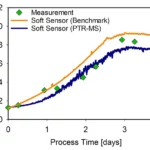How to predict continuous ultrafiltration from batch experiments
In our latest publication on filtration, we show how a singular ultrafiltration experiment in batch is used to predict continuous runs by using a smart hybrid model method. This allows for fast and effective estimations on how your batch ultrafiltration process would perform continuously.
Process development for continuous downstream processes is often performed in batch mode. The mode and process conditions, however, might not resemble the true continuous conditions. This is especially relevant for filtration processes where process knowledge such as membrane material, membrane area, and operational process parameters are simply adopted from already known products. Imagine you want to concentrate your product and screen different membranes in batch mode to find the one with the highest recovery and lowest flux decline.
When moving to continuous operations, parameters might not be the same. The flux and therefore the concentration factor (the target parameter in ultrafiltration which should stay the same in batch and continuous mode!) might behave differently due to the new setup and the use of multiple membranes. We present an efficient way to transition the knowledge from batch to continuous ultrafiltration.
How many membranes do you need?
When performing continuous ultrafiltration – so-called Single-Pass Tangential Flow Filtration (SPTFF) – a larger membrane area is required compared to batch ultrafiltration. Since there is no sample recirculation in SPTFF, larger membrane areas compensate for the reduced contact time between sample and membrane.
Fact box:
- Batch ultrafiltration: TFF (Tangential Flow Filtration)
- Attributes: Sample recirculation, smaller membrane area, longer contact times
- Continuous ultrafiltration: SPTFF (Single-Pass Tangential Flow Filtration)
- Attributes: No sample recirculation, larger membrane area, shorter contact time

But how many membranes do we need in SPTFF? Two, three or four times more than in TFF? Our proposed methodology helps to answer these questions, by breaking down the SPTFF process into multiple small TFF processes. Instead of performing an SPTFF with three membranes, we assume three TFFs with one membrane each. The effect of each membrane is accumulated, and the concentration factor is recorded as a function of the number of membranes. But there is one more thing to consider….
Most importantly: design space!
Since we assume multiple TFFs in a row, we must consider how the process parameters change between each step. Parameters such as reduced feed flow and pressure significantly impact the concentration factor. Here, the operational design of the training experiment becomes crucial. If we want to train the model with only one experiment, we need to cover all possible parameter combinations.

Let’s assume we employ three membranes for our SPTFF, and we use a pressure of 2 bar. The first membrane will experience 2 bar, but we cannot assume the same for the third membrane because the first two membranes cause a pressure drop. Maybe the third membrane experiences 1.5 or even only 1.0 bar. Only if we know how the pressures, flows and concentration change, we can predict the performance of the SPTFF accurately from just one training experiment in batch mode. Now, powerful predictions can be generated and the influence of various process parameters on the concentration factor quantified:

Graphs (a) and (b) show how the number of employed membranes and the chosen feed flow influences the concentration factor (given in conversion rate φ). Additionally, different starting concentrations (c) and SPTFF modes (serial and parallel) with varying numbers of membranes (d) influence the outcome as well. These Digital Twins help to find the most efficient setup for continuous and intensified bioprocessing.
Fully continuous Bioprocessing!
For continuous operations, we must understand our processes even better compared to batch mode. Consider a shift in feed flow or product concentration in the unit operation upstream of the SPTFF. How would this influence the behavior and the output of the filtration process? Our model takes into account the dependencies between target concentration, feed flow, and pressure. It can help to automatically adapt to changes in the feed flow or concentration to achieve the same quality at the end of each SPTFF process, enabling superior process and quality control.
You can find the full publication here: (open access: Hybrid modeling reduces experimental effort to predict performance of serial and parallel single-pass tangential flow filtration – ScienceDirect). Please contact us if you have questions or want to further discuss: contact@novasign.at.
